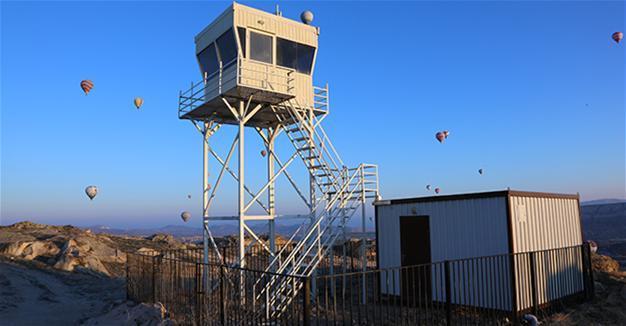Deadly balloon crashes in Turkey’s Cappadocia turn eyes to malfunctions, idle tower
Ömer Erbil - NEVŞEHİR

The rising number of balloon accidents in the touristic Cappadocia region of the Central Anatolian province of Nevşehir has turned eyes to technical malfunctions in the industry, particularly after the most recent accident on April 9 resulted in the death of France’s deputy consul to Istanbul.
Three major balloon accidents have taken place in the area in the last two months, resulting in the deaths of two people and wounding 50 others, making many tourists hesitant to take balloon tours.
French Deputy Consul Vince Caumontat was killed in the most recent accident when the balloon came into contact with an electrical line. Seven others were also injured in the crash, prompting the authorities to examine monitoring mechanisms for the balloons.
The main reason for most recent accidents are cited as sudden aerial changes, but expert pilots in the area say the common cause is the inability to check air traffic.
It has been revealed that an air traffic control tower built in 2014 has been idle ever since due to the inability to service it with electricity amid bureaucratic inefficiency. The tower, which was built by Directorate General of Civil Aviation in order to keep track of aerial changes in the region and air traffic, currently stands idle.
Balloon pilots in the area, from which hundreds of balloons take off every day, therefore still have to check air traffic by communicating with employees on the ground using walkie-talkies.
Pilots manage take offs and landings, as well as their distance from other balloons, via instructions they receive from employees on the ground.
Saying the idle air traffic control tower could play a crucial role in preventing accidents from taking place, the owner of one of the biggest balloon companies said “it is impossible to understand why it remains idle.”
“The tower could make a significant contribution. It’s impossible to understand why it doesn’t function. Pilots are unable to see what’s above them because of the balloon. When they want to go higher, they communicate with other pilots or teams on the ground. If there was a tower, air traffic would be easier to control. At the same time, they would be able to immediately convey meteorological changes to the pilots,” Halil Uluer, the owner of Anatolia Balon, told daily Hürriyet.
Uluer also noted that meteorological data is currently being received from the airports of neighboring provinces.
“Pilots want a system that can record sudden changes in the region. But it is said that the cost of this is around one million euros and the authorities cannot reserve that budget. Another major problem is the electric pylons. Balloon companies are asking for the high-tension lines, which threaten flight safety, to be put underground. At the very least they should be painted in order to make them more visible,” he said.
After an accident in 2013, which resulted in the death of three tourists and the wounding of 22 others, the Directorate General of Civil Aviation took precautions, including imposing the obligation to obtain permission before taking off and to put a registration number on all balloons.
However, critical information remains unknown by the authorities, including how many passengers are allowed in each balloon, whether propane gas is sufficient, and whether the pilot has completed the valid flight duration.
There are a total of 240 registered balloons and 25 companies that conduct balloon tourism in the Cappadocia region. Up to 100 balloons are allowed to take off simultaneously, while 50 balloons can also take off after half an hour.
Meanwhile, TOFAŞ basketball team player Juan Palacios, who was wounded in the accident, has spoken about the crash that killed Caumontat.
“The weather wasn’t windy. Everyone in the balloon was standing and everyone had places to hold onto. But we weren’t informed on what to do in the event of an emergency before taking off. After nearly an hour, we started descending. I didn’t hear any quarrel between the pilot and the passengers, but I felt that we were descending unusually fast. The first scream came from the pilot,” Palacios told daily Hürriyet, adding that when he opened his eyes he saw his girlfriend covered in blood.
“My girlfriend had to undergo surgery to her left cheekbone. She is a model and we are preparing to file a legal complaint due to her professional loss,” he said.
 The rising number of balloon accidents in the touristic Cappadocia region of the Central Anatolian province of Nevşehir has turned eyes to technical malfunctions in the industry, particularly after the most recent accident on April 9 resulted in the death of France’s deputy consul to Istanbul.
The rising number of balloon accidents in the touristic Cappadocia region of the Central Anatolian province of Nevşehir has turned eyes to technical malfunctions in the industry, particularly after the most recent accident on April 9 resulted in the death of France’s deputy consul to Istanbul.